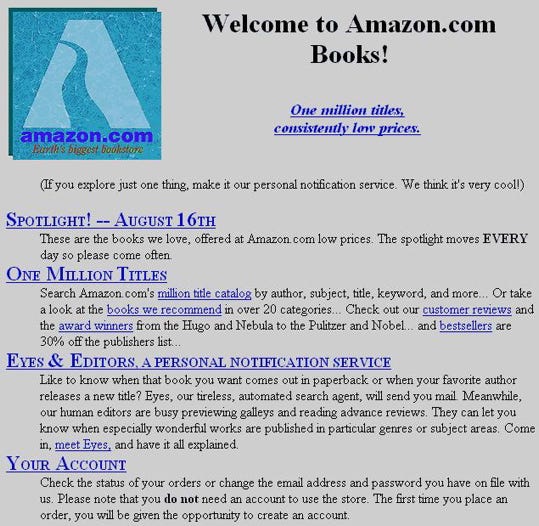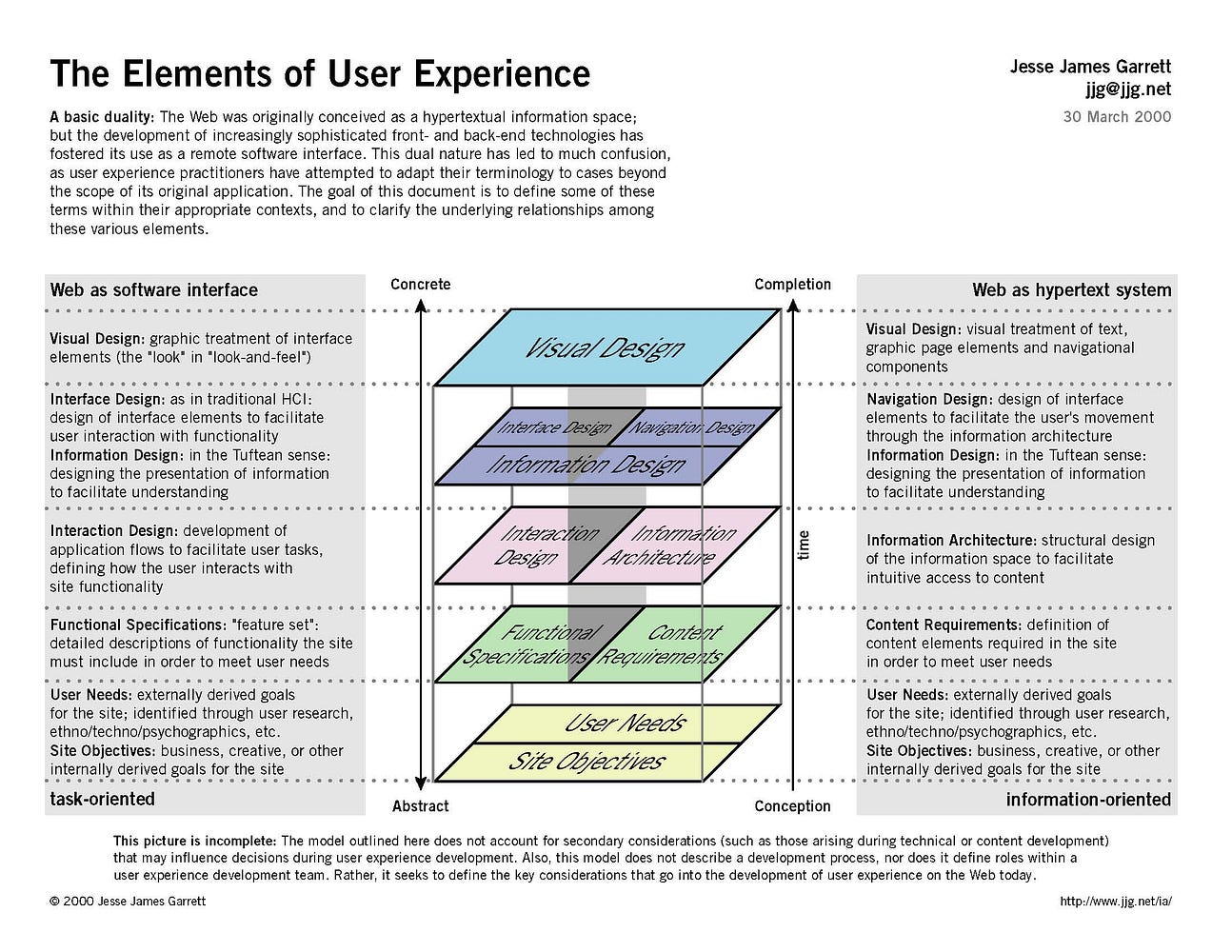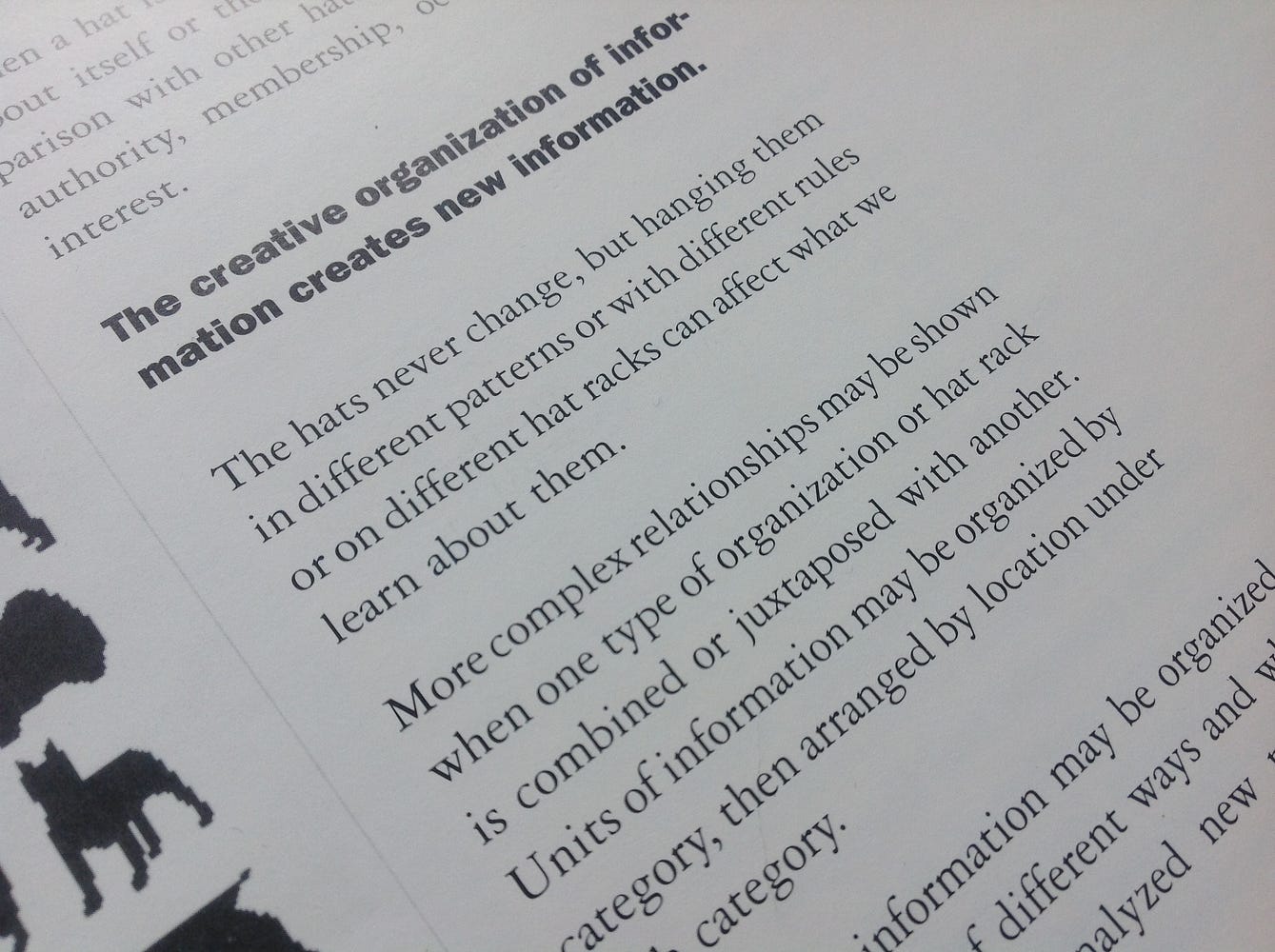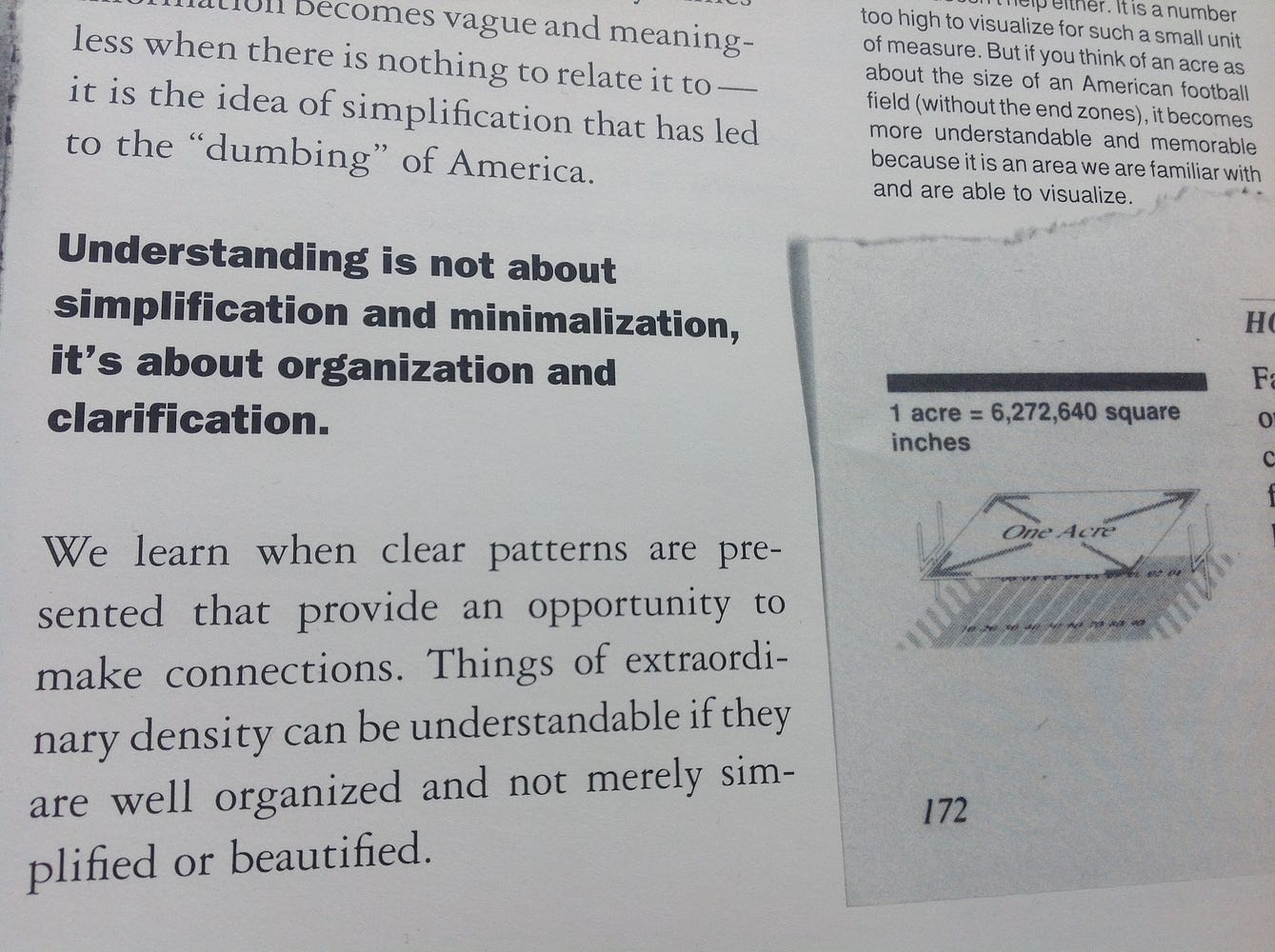There is a tsunami of data that is crashing onto the beaches of the civilized world. This is a tidal wave of unrelated, growing data formed in bits and bytes, coming in an unorganized, uncontrolled, incoherent cacophony of foam. None of it is easily related, none of it comes with any organization methodology….
~Richard Saul Wurman in Information Architects
Act One: The Birth of a Practice
When the internet was first becoming a thing, it was very different than it is now. It wasn’t very interactive. To be honest, it barely had any interface design either. The great bulk of websites were just walls of text arranged into a semblance of order by tables with the borders turned off. Interactivity was clicking “bookmark,” “set as homepage” or submitting a contact-us form. But what the Internet did have was information. Everybody put everything they had up on the web, from help pages to marketing brochures.
It was a mess, and someone had to make it all make sense. So while most software interaction designers declined to play with the very limited set of tinker toys the internet offered, others stepped up to fight the “tidal wave of data.” And they become the first Information Architects.

These early IAs were not trained in web design; nobody was. They came from a variety of backgrounds from Library Sciences (Lou Rosenfeld and Peter Morville) to Journalism (Jesse James Garrett) to painting (me), Graphic Design (Erin Malone) anthropology (Peter Merholz), landscape architecture, theater and more. We were entrepreneurs more than anything else, all excited by this brave new world. We dove in and cobbled together a way to make sure all this information could be found and understood.
It sounds like we all worked together, doesn’t it? Far from it. IA was invented in geographic silos with little sharing of knowledge until the first Information Architecture summit in 2000. Which means it had already formed factions.
The wisdom of the Library Science’s retrieval and organization approach was captured by Lou Rosenfeld and Peter Morville in the wildly popularInformation Architecture for the World Wide Web. It was an insightful and well written book and it published under the O’Reilly seal of approval. That meant wide adoption. It provided a model of how to organize complex information-rich sites used from Ann Arbor (where Argus plied its trade) to the East Coast.
But while Lou and Peter were using the library arts at Argus to bring order and sense to the volumes of printed materials being transferred to the Net, California was riding a a two-headed boom-beast. You all know about the dotcom boom. But do you recall there was also a consultancy boom? All the traditional companies rushed to the internet to try to avoid being disrupted. None of them really understood technology, so they looked for turn-key solutions. The new consultancies needed an internet process to sell! So they quickly rolled an information architecture loosely based on Richard Saul Wurman’s book Information Architects. It resembled what we now call UXD and focused on understanding and clarity over retrieval and navigation. Harder concepts for a new feild, but critical ones.
This Information Architecture turned out pretty darn well for the Sapients and Viants and MarchFirsts and Methods- until the dotcom crash took them down and with it, the memory of what they had created. While most folks practicing IA today remember Argus, few recall the bold innovation of Clement Mok’s Studio Archetype (where Peter Merholz and many other early west coast IAs were minted.)
The Californian view of information architect as leader/conductor/architect was supported by the other practioners featured in Information Architects; Lynne Styles, Paul Kahn, Maria Guidice and Nathan Shedroff (Maria and Nathan had both worked for Mr. Wurman at the Understanding Company) They trained a generation of IAs who believed it was their job to lead the design team to bridge business and user needs.

So when the two tribes met, the terms Big IA, Little IA was coined to describe the split in definition of IA. Little IA was concerned with metadata, taxonomies, and controlled vocabularies. Library stuff! Big IA was concerned with the entirety of the effort, that it was coherent and complete. Architecture-Wurman stuff!
And though we were a house divided, we were a strong house.
…Now for the good news: There is a dune on the beach. There is a breakwater in the ocean that is clearly emerging in these last fleeting moments of the 20th century. The breakwater is indeed breaking up the tsunami of data and focusing it in a more organized way to answer our questions and concerns. There is a new breed of graphic designers, exhibition designers, illustrators and photographers, whose passion it is tomake the complex clear….
~Richard Saul Wurman in Information Architects
The Information Archtiects thought everything would be okay. We joked about DTDT (defining the damn thing). We founded an Institute with three definitions that embraced the big and small nature of IA.
- The structural design of shared information environments.
- The art and science of organizing and labeling web sites, intranets, online communities and software to support usability and findability.
- An emerging community of practice focused on bringing principles of design and architecture to the digital landscape.
But this not about giving a history lesson. This is Chekov’s gun. Information Architecture had a potentially fatal tension. And it will go off in the second act.
Act Two: The Smallification of Information Architecture
The Big IA, Little IA article made room for both approaches to IA, but also noted an interesting new diagram that would eventually change how IA was perceived.

Elements of User Experience by Jesse James Garrett gave each discipline a spot in the User Experience firmament. And look how crisp the boundaries are! What a thick gray wall separates us from our brothers interaction design!
This diagram was followed by his best selling book that not only introduced IA to a new generation but also defined it for them. If you started your career with that book then IA is primarily concerned with organizing content and creating navigation. It’s an extremely good book, and Jesse (an IA himself) does not do a disservice to information architecture’s core nature. In fact, many folks would argue he brings a much-needed clarity to the defining the role. But there were consequences to putting IA into a small box not many could have foreseen.
At this point in time, the web had become interactive and Interaction Designers had arrived in force. As the mailing lists devoted to IA become contentious and rude (SIG-IA) or closed (IAI members only,) the IxDA list offered a open-to-all free alternative. As well, the interaction designer camp brought their passion and experience from software and many of the folks who might defined themselves as “Big IA” found it easy to move back and forth, learning exciting new thing and playing with new toys: gestural interfaces! Voice commands! And they stayed in the new camp. Many who might have become the next generation of IA’s became the first generation of IxD’s. Which would have been fine, except it seems like you can’t be both.
Sadly humans are related to chimpanzees and have some of their worst tendencies. One is to break into tribes and go to war to slaughter each other. Rather than work together, the IAI and the newly formed IxD focused on competing on what they saw as their unique value than focusing on intersections of common interest. The spoke of differnces rather than seekign itnersections. They chose the word OR over the word AND.
Jesse gave an talk at the Information Architecture Summit that sought to tear down the boundaries, but was widely misheard to say “IA is dead, long live User Experience.” It’s well worth listening to his original words, so carefully chosen.
He points out (from the transcript)
“In the marketplace, this is a zero-sum game. Every job req created for an “interaction designer” is one less job req for an “information architect” and vice versa. And the more “interaction designers” there are, the more status and authority and influence and power accrues to the IxDA and its leadership.
They get this, and you can see it play out in everything they do, including refusing offers of support and cooperation from groups they see as competitors, and throwing temper tantrums about how other groups schedule their conferences. Meanwhile, the IAs are so busy declaring peace that they don’t even realize that they’ve already lost the war.
This territorialism cannot go on, and I hope the IxDA leadership sees an opportunity here for positive change. These organizations should be sponsoring each other’s events, reaching out to each other’s membership, working together to raise the tide for everyone. ”
He asked us to come together under the umbrella of User Experience designer.
We are user experience designers. This is the identity we must embrace. Any other will only hold back the progress of the field by marginalizing an important dimension of our work and misleading those outside our field about what is most important and valuable about what we do.
He was right. I’m not sure he was heard.
“You are all User Experience Designers” was meant to heal. But the Interaction Designers just went back to their camps and the last of the IAs updated their business cards. I should be clear: the IA organizations did not reach out either, but focused even harder on defining a difference that was irreverent to making good work. All the organizations were so focused on what they were not, it’s not surprising many practitioners embraced a more inclusive definition: User Experience Design.

Another devastating event to IA had occurred around this time: the rise of Google. Much of “Little IA” was concerned with retrieval. Many of the techniques that were not about navigation were focused on fixing search. IA had become synonymous with controlled vocabularies and best bets. But Google gave everyone the belief that the retrieval problem was solved. And while that has proven to be far from true in smaller information environments like intranets, the idea that humans could handcraft anything that could compete with a learning algorithm seems laughable. Suddenly library science seemed as relevant as … libraries.
So IA was both made small and made unnecessary.
Google fixed search.
No one navigates.
You don’t need IA for software-as-a-service sites, you need interaction design.
You don’t need IA.
In California, the title disappeared and Information Architecture seemed like a strange fad left over from the dot-com boom like Pets.com.
And where was I? I promised this was personal. At the end of act one, I had written a book on Information architecture, and took the Big IA route. I tried to balance user research, interaction design and “little IA” into a coherent whole. It sold very well. But the day it was published, I was working at Yahoo as an Interaction Designer. When the second edition came out, I was a Product Manager at Linkedin. Titles have never seemed very important to me, but I was mistaken. I should have fought for Information Architecture at Yahoo, since that’s really what I was doing. I was working on search, and making sure that tsumani of data was understood and harnessed.
Although by Linkedin I was a product manger and not a designer of any kind of UX, I still sought to bring order and understanding in a new tsunami: the social stream. Information Architecture is a way of thinking for me. It is a way of approaching any problem: thinking about products, making sense of the world around me. There will be no third edition. I love IA, but I’ve moved on to other kinds of work. Not because IA was lacking but because I am a happy dilettante. I was never a specialist, but someone who loved the chaos of those early wild-west days of the web, and I still seek the next frontier.
No matter what I do though, I will think like an information architect.
Act Three: The New Information Architects
…I call this new breed of talented thinkers Information Architects and this book was created to help celebrate and understand the importance of their work—a work which inspires hope that as we expand our capabilities to inform and communicate that we will value, with equal enthusiasm, the design of understanding.
~Richard Saul Wurman in Information Architects
This year Peter Merholz stated that UX Stunted IA’s Growth and started a firestorm of argument. Some people accused him of just making trouble to make trouble. While making trouble is not out of character for him, he isn’t wrong either. IA has taken a long time to find its feet after the one-two punch of interaction design and user experience (And I haven’t even brought up Content Strategy!) No amount of “let’s be friends” will change the fact that IA has stagnated in the years following the rise of UX. He’s also not wrong that we need IA and IA thinking more than we ever have.
But…
IA is not dead. Thank goodness. Because no matter whether you think your digital product has “content” or not, the world is made of data. And somebody needs to make that world of data make sense to the humans who live in it. In fact, I’m even going to argue it’s making a comeback.
Jesse Jame Garrett asked in his plenary where the great works of Information Architecture were. I say they are just showing up now. The are not pseudo-libraries or pseudo-buildings. They are understanding spaces made of information. They are new works that make data dance. They make the impossibly complex clear.
For example: Foodpairing.
Bernard Lahousse does not know he is an information architect. Considering he is giving this talk at an Interaction Design conference, I’m not surprised. Although he may consider himself a bio-engineer and an gastronome, he is definitely an information architect because he is helping us understand something we thought we knew more deeply through organization.

Foodpairing breaks ingredients into their unique flavor components, and then creates relationship trees that help chefs discover brave new combinations that delight the tongue.
Like the Pandora Music Genome and The Netflix Recommendation Algorithm, Foodpairing takes apart something we thought we knew, then reinvents our understanding by revealing hidden relationships. First we understand, then we eat.

When I commented on twitter that the Foodpairing talk was a information architecture talk, one person replied, “why? It’s not about controlled vocabularies or metadata.” That is like saying a talk on mapmaking isn’t a design talk because it doesn’t mention photoshop. Taxonomies, controlled vocabularies, those are just tools. Metadata is just a material. Information Architecture is about making meaning out of piles of facts. Who cares how you do it, or in what medium?
The new ihop menu is a another example of how understanding the data and understanding the humans who need to consume it can lead to design and business wins. It was made by an Information Architect who knew her point of view and tools could be applied to more than a website.
The new Information Architects look rather like the very oldest. Dan Klyn is obsessed with Richard Saul Wurman’s legacy (and well he should be) and is driving us all to understand what good means in different contexts.
Abby Covert is experimenting with new forms of communication, such as children’s books, to find better ways to make the complex clear. Andrea Resmini is exploring ambient information and Andy Fitzgerald’s Taxonomy for AppMakers at the 2013 summit made taxonomies a sensible approach to mobile. Medium does not matter, tools do not matter, but the goal ofunderstanding out of chaos through order does. This is a discipline involved in inventing solutions to new problems as they arrive.
Dan Brown, in his talk on Designing Rules, points toward a new relevance for the information architect in a post-Google world. Just as furniture makers had to choose between making patterns for IKEA or continuing to hand craft furniture for a shrinking — but appreciative— market, so IAs must decide if they will handcraft bestbets or create the rules for making them. Peter Morville, one of the “my two dads” of Information Architecture moved on to search. Search is far from solved. It and recommendation engines— the push to search’s pull —provide more than enough of a fun rule space to keep IAs busy for many years to come.
As well, there is a new data crises. Karl Fast points out that we are drowning in small data problems such as email and photos. We are producing information at such a pace we can no longer make sense of it. We are the tsunami. There is no data more precious or more personal. We need the next generation of IAs to make our lives make sense.

Information Architects are in the understanding business. Understanding is their north star, and organization and clarification are their tools. We may have a new tsunami of data. But we also have information architects ready to help. Let us never forget how much we need them.
Today World IA Day is celebrating the art and science of Information Architecture across 24 cities on 6 continents. Today I celebrate all the brave IA’s who have not given up on us.
I raise my glass to you. See you in San Diego.
AFTERWORD
There are many obvious calls-to-action here. I am merely an observer these days, engaged in bringing understanding and order to the next generation of entrepreneurs.
So just a few random ideas:
Re-commit to the IAI, or tear it down and help build the next thing. Abby Covert, one of the new kids on the block, just stepped up as president and maybe we can help her reignite the embers before she gets too tired to fight this fight. Find her and the other directors at a local event and tell them you support them and you’re ready to help.
The IxDA stopped competing some time ago with IA, and have been peacefully coexisting, with practitioners of UX easily trafficking across events and conversations. But I would like the IxDA to do more. To recognize if we lose IA, we lose a body of knowledge and a lens of problem solving that is critical to the digital products we all love. Be a good big brother and reach out a hand to make cross-organization cooperation with the IAI happen. Teach your new interaction designers to learn from information architecture. The peanut butter of understanding is in the chocolate of use, and you can be so much more delicious together.
Samuel Bowles made a modest proposal at the last Interactions Conference that the IXDA and the IAI hold their conferences back to back with a UX summit in between. While that exact scenario might be hard to pull off, collabarting on a summit is a kinda hella awesome idea.
Yes, I said hella.
Publish. The world we live in is still being shaped by books. If this short history tells us anything, the right book in the right time can shape the direction of discipline.
It’s time for a new edition of Information Architects. Let’s look beyond the title people have and instead at the work being done. Invite the innovators in understanding in, and make them part of Information Architecture.
Reach out across the world. WIAD is a great step in the right direction. Look east as well as west. Terrific IA work is being done in Japan. We are all digital citizens facing the same problems. Let us collaborate towards the future.
And IAs: consider the wide wonderful world beyond the controlled vocabulary. The world is big and messy. Don’t you want to tidy it up?